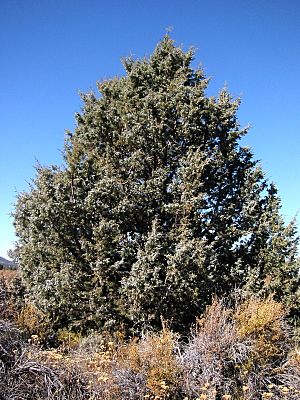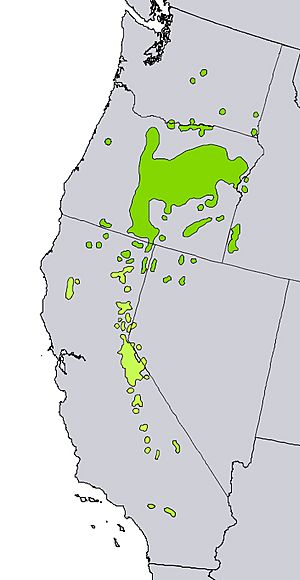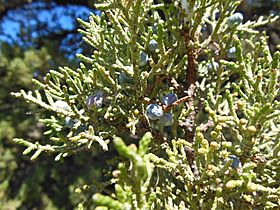Juniperus occidentalis facts for kids
Quick facts for kids Juniperus occidentalis |
|
|---|---|
 |
|
| At Lava Beds National Monument | |
| Conservation status | |
| Scientific classification | |
| Genus: |
Juniperus
|
| Species: |
occidentalis
|
 |
|
| Natural range in dark green (light green is Juniperus grandis) | |
The Juniperus occidentalis, also known as the western juniper, is a type of shrub or tree. It grows naturally in the western United States. You can find it in mountains at high altitudes, from about 800 to 3,000 meters (2,600 to 9,800 feet). Sometimes, it grows as low as 100 meters (330 feet). This tree is not considered endangered. In fact, its population is growing, which is good news!
Contents
What Does the Western Juniper Look Like?
Western juniper branches are medium thick, about 1 to 1.6 millimeters wide. Its leaves are small and scale-like, about 1 to 2 millimeters long. They grow in pairs or groups of three. Young plants have longer, needle-like leaves, about 5 to 10 millimeters long.
Cones and Seeds
The cones of the western juniper look like berries. They are 5 to 10 millimeters wide and are blue-brown with a white, waxy coating. Each "berry" usually holds one to three seeds. These cones take about 18 months to fully ripen. The male cones are smaller, about 2 to 4 millimeters long. They release their pollen in the early spring.
Western Juniper's Relatives
The Sierra juniper, called Juniperus grandis, is very similar to the western juniper. Some scientists even think it's just a different type, or variety, of the western juniper.
How to Tell Them Apart
Scientists can tell the two types apart by where they grow and how they look. They also study their natural oils and DNA (genetic evidence).
- Western Juniper (Juniperus occidentalis): This type grows in parts of Washington, Oregon, Idaho, California, and Nevada. It's usually a shrub or a small tree, about 4 to 15 meters (13 to 49 feet) tall. Some very tall ones have been found in Oregon, reaching over 26 to 28 meters (85 to 92 feet). About half of these plants have both male and female cones on the same tree. The other half have cones of only one sex. Their cones are 7 to 10 millimeters wide.
- Sierra Juniper (Juniperus grandis): This type is found in California and western Nevada, mainly in the Sierra Nevada and San Bernardino Mountains. It's a medium-sized tree, usually 12 to 26 meters (39 to 85 feet) tall, with a thick trunk up to 3 meters (10 feet) wide. Most of these trees have cones of only one sex. Their cones are 5 to 9 millimeters wide. The Bennett Juniper in California is a famous example. It's thought to be around 3,000 years old, making it one of the oldest and largest. It's 26 meters (85 feet) tall with a trunk 3.88 meters (12.7 feet) wide!
Where Western Junipers Live
Western junipers usually grow in dry, rocky places. They do well here because there's less competition from bigger trees like ponderosa pine and coast Douglas-fir. In very windy, high-altitude spots, they might grow low to the ground, even when they are old. This is called a krummholz habit. Sometimes, you might find hybrid trees where western junipers have mixed with Juniperus osteosperma.
Western Juniper's Role in Nature
The cones of the western juniper are an important food source for several birds. Birds like the American robin, Clark's nutcracker, phainopepla, and cedar waxwing eat the cones. When they digest the cones, they help spread the seeds in their droppings.
Insect Visitors
These trees can also have small bumps called galls on them. These galls are caused by a tiny insect called the juniper tip midge (Oligotrophus betheli). The galls are usually purple, fading to brown, and are about 1 to 2 centimeters wide.
Western Juniper and Fire
Over the last 20 years, the number of western junipers has grown a lot in the western United States. This change is partly because there have been fewer wildfires. It's also due to too much grazing by livestock and changes in the climate, making it wetter and milder.
Scientists have studied old fire scars on trees to see when western junipers started to spread more. They found that the spread began between 1875 and 1885. It grew fastest between about 1905 and 1924.
Since the 1990s, people have been using controlled fires, called "prescribed fires," to help manage the growth of western junipers. These fires have shown good results in helping other plant communities grow back after the fires.





